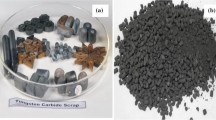Abstract
Tungsten (W) is one of the most important metals in various industries, particularly in the machining industry. At least 60% of W is consumed in cemented carbide or super-hard alloys in Japan and the USA. The major recycling method for cemented carbides is the hydrometallurgical process combined with the roasting step, which oxidizes W in scrap into tungsten oxide. However, this conventional process requires repetition of roasting and dissolution in some cases, which makes the process costly and inefficient. In contrast, the molten salt process has specific advantages in terms of processing rate and simplicity. In this study, the recycling processes for W using molten salt are reviewed. Subsequently, our new recycling process using molten hydroxide is introduced, and recent data on this process discussed.
Access this chapter
Tax calculation will be finalised at checkout
Purchases are for personal use only
Similar content being viewed by others
References
US Geological Survey (2016) Mineral commodity summaries
JOGMEC (2019) Material flow of mineral resources 2018, Tungsten
Oishi T (2017) Tungsten recycling technologies using Molten salts. Kinzoku 87:771–776 (in Japanese)
Lassner E (1995) From tungsten concentrates and scrap to highly pure ammonium paratungstate (APT). Int J Refract Met Hard Mater 13:35–44
Lassner E, Schubert WD (1999) Tungsten-properties, chemistry, technology of the element, alloys, and chemical compounds. Plenum Publishers, New York, pp 377–385
Shedd KB (2005) Tungsten recycling in the United States in 2000. US Geological Survey
Iguchi T, Ikegaya A (2008) Recycling of tungsten. In: Harada K, Nakamura T (eds) Technology of alternatives and recycling of rare metals. CMC Publishing Co, Ltd., Tokyo (in Japanese)
Nose K, Okabe TH (2011) Recycling technology of tungsten. Kinzoku 81:908–915 (in Japanese)
Itoh H (2013) Recent trend of rare metal recycling. J MMIJ 129:97–106 (in Japanese)
Bhosale SN, Mookherjee S, Pardeshi RM (1990) Current practices in tungsten extraction and recovery. High Temp Mater Processes 9:147–162
Ishida T, Itakura T, Moriguchi H, Ikegaya A (2012) Recycling technique for cemented carbide tools and development of tungsten-saving tools. SEI Tech Rev 181:33–39
Li KC, Wang CY (1955) Tungsten. Reinhold Publishing Corporation, New York, pp 175–176
Simon R (1981) DE3144295 (Germany patent)
Douglass AD, Reilly KT, Landmesser JE (1986) US4603043
Morishita M, Yamamoto H, Ikebe M, Yanagida H, Ueno T (2014) PCT. International patent, WO2014/045579
Yamamoto Y, Sasaya K, Fudo T, Nakano A, Yamanaka S, Iguchi T, Sato F, Ikegaya A (2010) PCT. International patent, WO2010/104009
Hayashi T, Sato F, Sasaya K, Ikegaya A (2016) Industrialization of tungsten recovering from used cemented carbide tools. SEI Tech Rev 189:8–14
Scott FH (1955) United Kingdom patent GB791925
Yasuda K, Nozaki F, Uehata R, Hagiwara R (2020) Oxidative dissolution of tungsten metal in Na2CO3 under Ar–O2–CO2 atmosphere. J Electrochem Soc 167:131501
Lohse M (1996) PCT. International patent, WO96/041768
Itakura T, Ikegaya A, Yamamoto Y (2016) Japanese patent JP6018958
Oishi T, Yaguchi M, Tanaka M (2013) Anodic dissolution of tungsten in a molten sodium hydroxide. J MMIJ 129:707–712
Oishi T, Yaguchi M (2017) Influence of partial pressure of water vapor on anodic dissolution of tungsten from super hard alloy tools in molten sodium hydroxide. Int J Refract Met Hard Mater 69:254–258
Oishi T, Yaguchi M (2018) Solubility of sodium tungstate in molten sodium hydroxide. Electrochemistry 86:61–65
Author information
Authors and Affiliations
Corresponding author
Editor information
Editors and Affiliations
Rights and permissions
Copyright information
© 2022 The Minerals, Metals & Materials Society
About this paper
Cite this paper
Oishi, T. (2022). Recycling of Tungsten by Molten Salt Process. In: Lazou, A., Daehn, K., Fleuriault, C., Gökelma, M., Olivetti, E., Meskers, C. (eds) REWAS 2022: Developing Tomorrow’s Technical Cycles (Volume I). The Minerals, Metals & Materials Series. Springer, Cham. https://doi.org/10.1007/978-3-030-92563-5_7
Download citation
DOI: https://doi.org/10.1007/978-3-030-92563-5_7
Published:
Publisher Name: Springer, Cham
Print ISBN: 978-3-030-92562-8
Online ISBN: 978-3-030-92563-5
eBook Packages: Chemistry and Materials ScienceChemistry and Material Science (R0)




